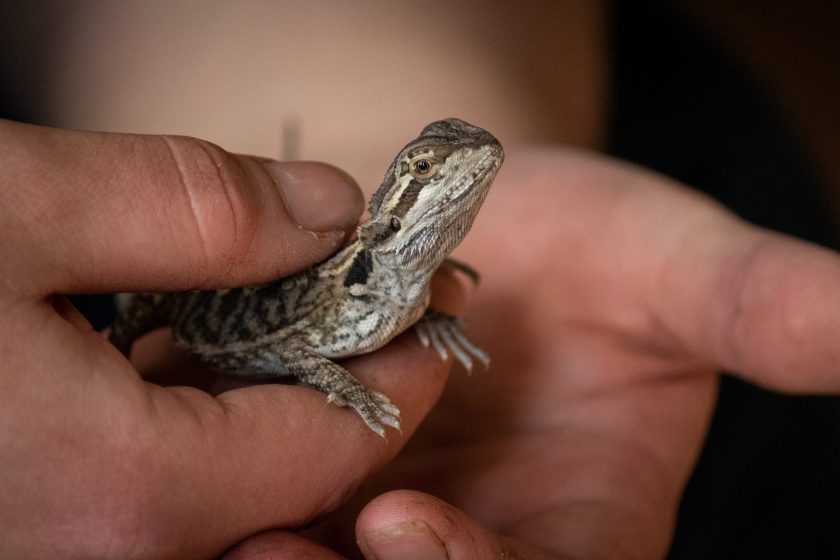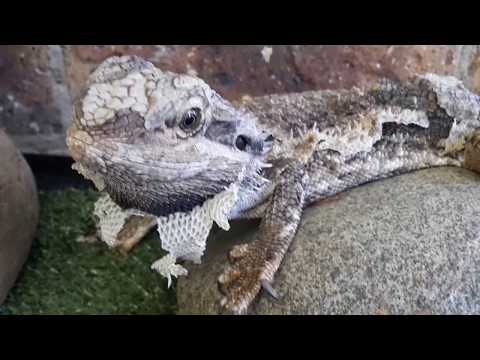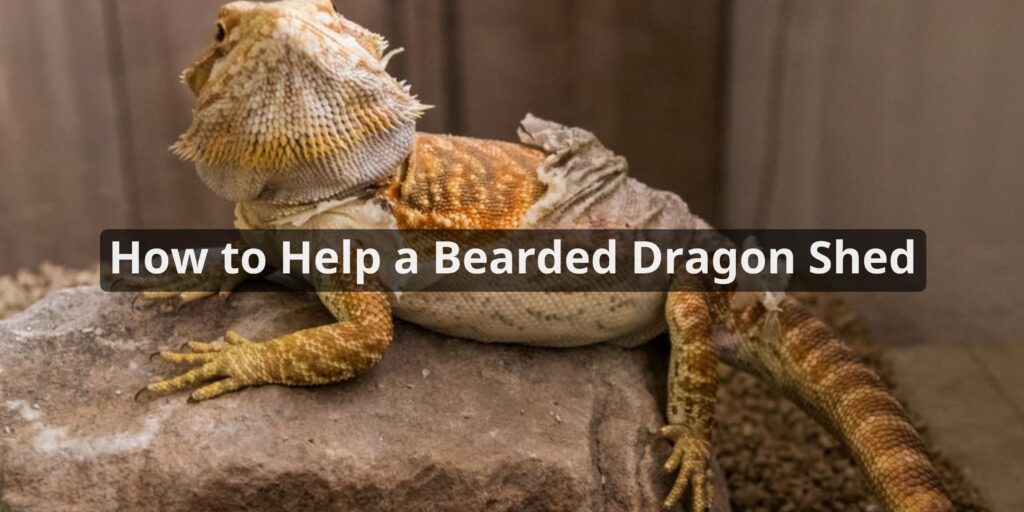Shedding is a natural process for bearded dragons as they grow and their skin needs to be replaced. However, sometimes dragons can have difficulty getting all of the old skin off on their own. As a bearded dragon owner, it’s important to understand the shedding process and know how to help a bearded dragon shed if they are having problems shedding completely.
Understanding the Shedding Process

Bearded dragons shed their skin in patches, similar to the way snakes shed. The process usually occurs every 4-6 weeks as they are growing. Shedding helps get rid of any old scales or skin and allows new scales to form. Here are some key things to understand about the shedding process:
- Shedding is triggered by hormonal changes as the dragon grows. Males often shed more frequently than females.
- Shedding usually starts on the legs, tail, and body. The skin on the head, around the nostrils, and the eyelids is shed last.
- Before shedding, the color of your dragon may appear more dull. Their skin may also look flaky or ashy. This is normal.
- Shedding is completed in one piece, like a garment being pulled off. It should not come off in patches or pieces.
- The whole process can take 1-2 weeks to fully complete.
Helping Your Bearded Dragon Shed
In most cases, bearded dragons can complete the shedding process on their own without any issues. However, there are some things you can do to help make sure the old skin comes off cleanly and completely:
Increase Humidity
Low humidity can make it harder for the skin to separate from the new layer beneath. Try misting your dragon’s tank several times a day or provide a humid hide to help loosen the skin. The humidity level should be 40-50%. Avoid keeping it too humid for too long, as this can cause other health issues.
Provide Rough Surfaces
Giving your bearded dragon access to rough, textured surfaces in their tank helps them “scratch off” the shedding skin. Place logs, branches, rocks, or reptile hammocks in the enclosure. You can also move their regular décor items closer together so they have to squeeze between them.
Give Warm Soaks
A 10-15 minute soak in shallow, lukewarm water can significantly help hydrate the skin and make it easier to shed. Make sure the water only comes up to your dragon’s shoulders. Gently use your fingers or a soft brush to help loosen skin on the toes, tail, and other hard-to-reach spots.
Use Shedding Aids
There are several products made specifically to help reptiles shed, such as Repti Shedding Aid. These are non-toxic creams or sprays you apply directly to stubborn skin patches. Always thoroughly rinse off any product afterward and discontinue use if irritation occurs.
Increase Healthy Diet Items
Make sure your bearded dragon is getting enough hydration and nutrients, like vitamin A. Provide plenty of greens, vegetables, and live prey items. Fruits with high water content can also be given 2-3 times per week.
Adjust Environmental Factors
Double check your tank temperatures, lighting, and other habitat conditions are optimal. Shedding problems can indicate something in the environment is off. Make adjustments as needed and monitor.
Assisting a Problematic Shed
Even with the right care, bearded dragons can sometimes have a hard time getting all of their old skin off. Signs your dragon needs shedding assistance include:
- Skin leftover on feet, tail, head, or body after 2+ weeks
- Skin coming off in patches or pieces
- Discoloration, inflammation, or raw areas on the skin
- Change in appetite or energy levels
If your dragon still has remnants of skin left after attempting the above recommendations for several days, it’s time to provide hands-on assistance. Here’s how to safely help remove stubborn shed skin:
Soak in Lukewarm Water
Give your dragon a 10-15 minute soak. Use a soft toothbrush, Q-tip, or gentle rubbing with your fingers to help loosen and remove the skin. Focus on problem areas like the toes, nostrils, eyelids, and tail.
Apply Shedding Aid Products
After soaking, apply a reptile shedding aid product and let it soak in for 5-10 minutes. Gently work it over stuck skin with a soft brush. Rinse thoroughly. Only reapply if needed every few days.
Use a Humid Hide Box
Place your dragon in a plastic container lined with damp paper towels for 30-60 minutes. The moist enclosed space helps hydrate and loosen skin. Check on them frequently.
See a Vet
If you’ve tried all other options with no success, a vet visit may be needed. The vet can provide medication to help with shedding and make sure there is no underlying health issue. Removal of stuck shed by a vet is safe and does not cause pain.
Prevention of Future Shedding Issues

Once you’ve helped your bearded dragon through a difficult shed, you’ll want to take steps to prevent it from recurring. Here are some tips:
- Maintain proper humidity level (40-50%) at all times
- Provide multiple rough surfaces and climbable decor
- Give weekly gentle brushes with a soft toothbrush
- Offer daily soaks during shedding periods
- Keep enclosure and basking temperatures optimal
- Feed a highly varied, vitamin-rich diet with good hydration
- Limit stressful handling during shedding periods
- Keep their habitat very clean to prevent infection
- Take a proactive approach at first signs of shedding
Conclusion
Shedding is a natural process bearded dragons go through as they grow. While it usually goes smoothly, occasionally a dragon may need some extra assistance getting all of the old skin off. With the proper humidity, soaks, aids, and vet care if needed, you can safely help your dragon complete their shedding. Preventing future issues relies on optimizing their husbandry, nutrition, and habitat. With your help, your bearded dragon can keep their skin and scales healthy through each shed.
FAQs About How to Help a Bearded Dragon Shed
Should I assist my bearded dragon in removing stuck shed skin, and if so, how?
Assist only if the shed is stuck on toes or extremities, as it can cause constriction. Soak the affected area, and then use a soft, damp cloth or cotton swab to carefully rub the shed skin away. Avoid pulling or causing injury.
What should I feed my bearded dragon during shedding to support their health?
Continue offering their regular diet of insects and vegetables. Ensure calcium and hydration are maintained. Consider providing slightly softer food options, such as cucumber or squash, to ease chewing if their appetite decreases.
Are there common problems or complications associated with shedding, and how can I address them?
Complications can include retained eye caps or incomplete shedding. Address these issues by increasing humidity, offering warm baths, or consulting a reptile veterinarian for professional assistance.
How often does shedding occur in bearded dragons, and does it vary by age?
Shedding frequency varies but generally occurs every 4-8 weeks for juveniles and less often for adults. Young dragons shed more frequently as they grow rapidly.
What role does lighting play in the shedding process, and should I adjust it?
Proper UVB lighting is essential for calcium metabolism, which indirectly affects shedding. Ensure your UVB bulbs are fresh and provide adequate exposure. No specific adjustments are needed solely for shedding.
Can I use commercial shedding aids or products, and do they work effectively for bearded dragons?
Commercial shedding aids can be used cautiously but are often unnecessary if you maintain proper humidity and offer warm baths. Consult with a vet before using any products, and be cautious of potential irritants or allergies.



